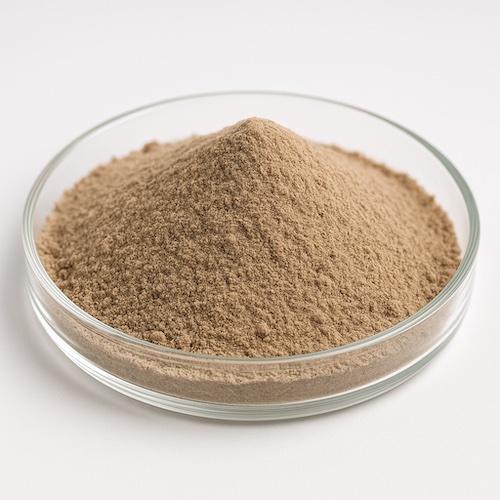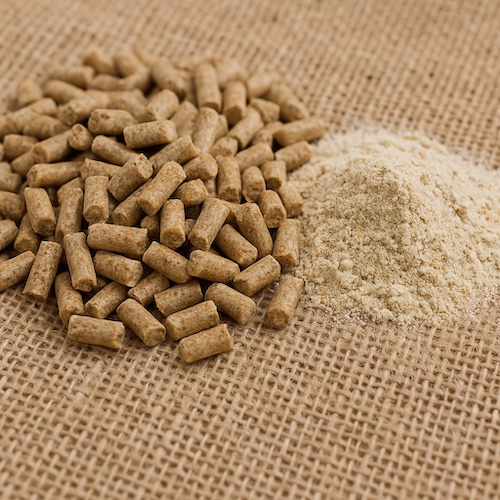Mycotoxin Binders in Animal Feed: Strategies for Livestock and Poultry Health
Introduction
Mycotoxins are toxic secondary metabolites produced mainly by fungi of the genera Aspergillus, Fusarium, and Penicillium. Even at low concentrations, these compounds can severely impair animal health and productivity. They affect the liver, kidneys, reproductive system, and immune function, while also reducing feed intake and performance. For dairy cattle, aflatoxin B1 can be metabolized into aflatoxin M1 and excreted in milk, posing a direct risk to human health.
Controlling mycotoxins is one of the biggest challenges in animal nutrition. Because it is nearly impossible to prevent contamination completely, the use of mycotoxin binders in feed has become a crucial strategy worldwide.
Major Mycotoxins in Animal Feed
Based on research and practical observations (including articles from Fartak), the most important mycotoxins in livestock and poultry production are:
-
Aflatoxins (B1, B2, G1, G2): Produced by Aspergillus flavus and A. parasiticus. Highly hepatotoxic and carcinogenic.
-
Ochratoxin A: Produced by Aspergillus and Penicillium. Damages kidneys and reduces growth.
-
Zearalenone: Produced by Fusarium species. Estrogenic effects, leading to reproductive disorders.
-
Deoxynivalenol (DON or vomitoxin): Reduces feed intake, immune suppression, and gut damage.
-
Fumonisins: Affect liver and nervous system, especially in pigs and poultry.
Risk Factors for Mycotoxin Contamination
-
Pre-harvest: Plant stress (drought, insect damage, mechanical injury), fungal colonization, climate factors.
-
Post-harvest: Improper drying, poor storage, silage exposure to oxygen, high humidity, and long storage periods.
-
Feed processing: Cross-contamination during milling or transport.
Fartak’s Persian articles emphasize the special vulnerability of silage as a substrate: its high moisture and semi-anaerobic conditions make it prone to both primary and secondary fungal growth. Hot spots of contamination are common, making representative sampling essential.
Detection and Monitoring
Because mycotoxin contamination is heterogeneous, reliable sampling and testing methods are critical.
-
ELISA kits: Rapid, cost-effective, suitable for screening.
-
HPLC and LC-MS/MS: Gold standard methods for quantitative and multi-mycotoxin detection.
-
On-farm observation: Mold growth, heating of silage, reduced palatability, and performance drop in animals are indirect indicators.
Mechanism of Action of Mycotoxin Binders
Mycotoxin binders work by reducing toxin absorption in the gastrointestinal tract. Their mechanisms include:
-
Physical Adsorption: Binding toxins on their surface, preventing intestinal absorption (e.g., bentonite, zeolite).
-
Biological Transformation: Enzymes or microbes degrade toxins into non-toxic metabolites (e.g., zearalenone hydrolase).
-
Immune and Nutritional Support: Antioxidants (vitamin E, selenium), probiotics (yeast), and organic acids reduce oxidative stress and secondary damage.
Types of Mycotoxin Binders
1. Aluminosilicates (Clays)
-
Bentonite, montmorillonite, zeolite.
-
High efficiency against aflatoxins.
-
Advantages: cheap, widely available (as highlighted in Iranian feed mills).
-
Limitations: less effective against zearalenone, DON, fumonisins; may reduce nutrient bioavailability; long-term use increases die wear in pellet mills.
2. Yeast Cell Wall Derivatives
-
β-glucans and mannan-oligosaccharides (MOS).
-
Bind zearalenone and trichothecenes.
-
Additional benefits: improve gut health and immunity.
3. Enzymatic and Microbial Degraders
-
Zearalenone hydrolase, DON epoxidase, fumonisin esterase.
-
Probiotic strains such as Lactobacillus and Bacillus species can detoxify certain mycotoxins.
-
Effective but more expensive and strain-specific.
4. Nutritional and Antioxidant Additives
-
Vitamin E, selenium, silymarin, organic acids.
-
Do not directly bind toxins, but reduce oxidative stress and organ damage.
Benefits of Mycotoxin Binders
-
Improved feed safety and reduced toxin carryover to animal products.
-
Higher feed intake and better feed conversion ratio (FCR).
-
Reduced mortality and veterinary costs.
-
Better reproductive performance and overall herd/flock productivity.
-
Enhanced food safety for consumers.
Challenges in Mycotoxin Control
-
Mycotoxins often occur together, with synergistic effects.
-
No binder is universally effective against all toxins.
-
Dosage, pH, feed composition, and animal species affect efficacy.
-
Over-reliance on binders can lead to neglect of good feed management practices.
Therefore, binders should always be part of a multi-step strategy: resistant crop varieties, good harvesting and storage, regular testing, and proper feed mill management.
Conclusion
Mycotoxin binders are a vital tool in modern livestock and poultry production. While clays such as bentonite remain widely used, yeast derivatives and enzyme-based solutions provide broader protection. The best approach combines different types of binders with strict feed management. This integrated strategy reduces economic losses, safeguards animal health, and ensures food safety for human consumers.
References
-
Scientific References:
-
Jouany, J.P., & Diaz, D.E. (2005). Mycotoxins in feeds: effects in animals and residues in food. FAO.
-
Kabak, B., Dobson, A.D.W., & Var, I. (2006). Strategies to prevent mycotoxin contamination of food and animal feed: a review. Critical Reviews in Food Science and Nutrition, 46(8).
-
Murugesan, G.R. et al. (2015). Mycotoxins: Occurrence, toxicology, and detoxification. Animal Nutrition, 1(3), 272–283.
-
EFSA (European Food Safety Authority) Scientific Opinions on mycotoxin risks.
-



